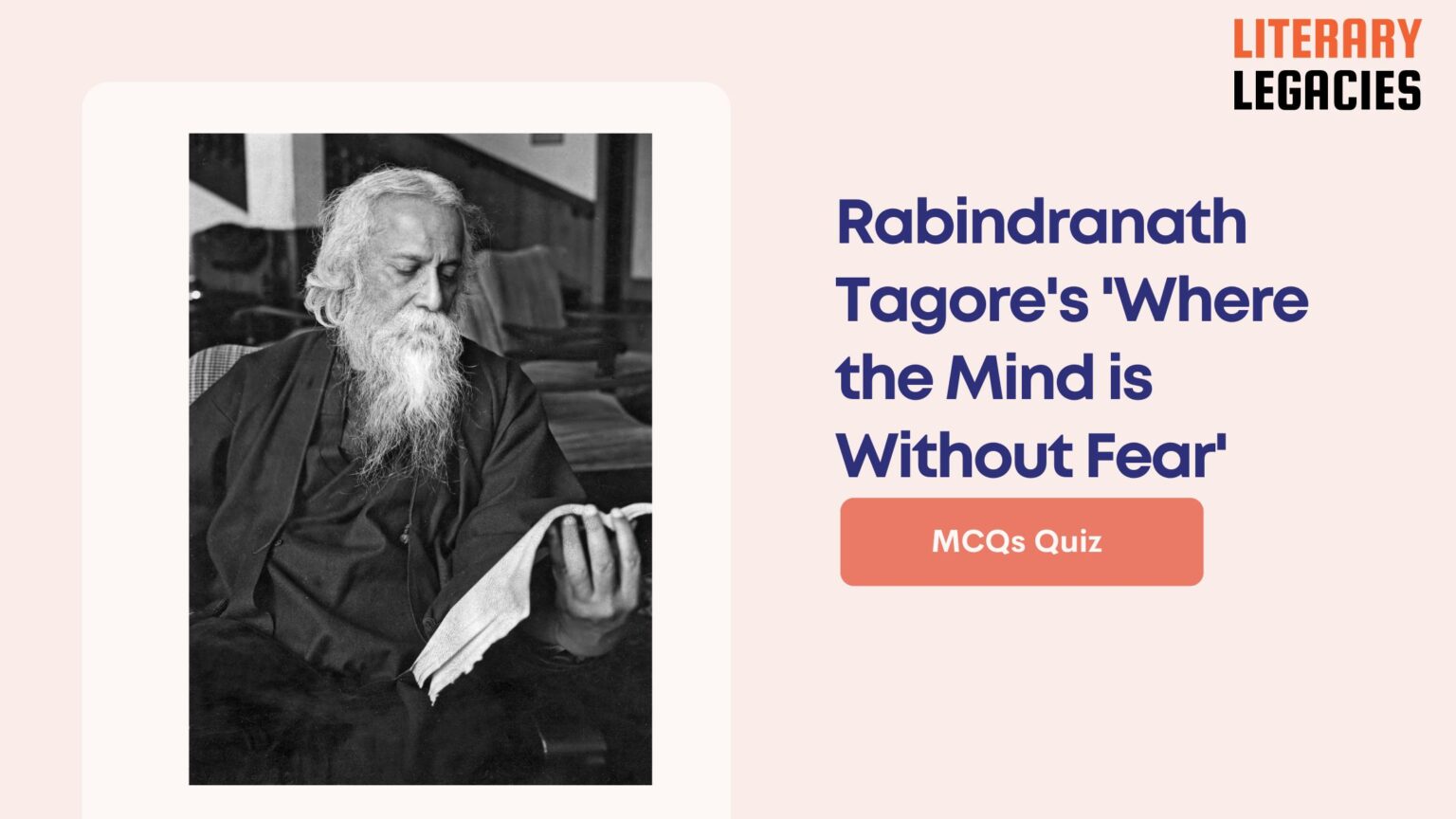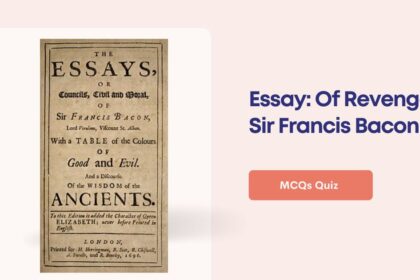1. What was the original Bengali name of the poem ‘Where The Mind is Without Fear’?
A. Gitanjali
B. The Bengali Poem
C. Chitto Jetta bhoyshunyo
D. Indian Prayer
Answer: Chitto Jetta bhoyshunyo (C)
Chitto Jetta bhoyshunyo is the original Bengali name of the poem.
2. When was the Bengali poem ‘Where The Mind is Without Fear’ published?
A. 1911
B. 1912
C. 1909
D. 1910
Answer: 1910 (D)
The Bengali poem was published in 1910 as a part of Tagore’s Gitanjali.
3. Why did Tagore create an English translation of ‘Where The Mind is Without Fear’?
A. To popularize it in Bangladesh
B. At William Rothenstein’s request
C. To read aloud at the Indian National Congress meeting
D. To publish in Indian textbooks
Answer: At William Rothenstein’s request (B)
Tagore created the English translation at William Rothenstein’s request in 1911.
4. What was the original name of the poem when it was read aloud at the Indian National Congress meeting in 1917?
A. Chitto Jetta bhoyshunyo
B. Gitanjali
C. Where The Mind is Without Fear
D. Indian Prayer
Answer: Indian Prayer (D)
The English translation was known as ‘Indian Prayer’ when Tagore read it aloud at the meeting.
5. Which of the following groups is known to appreciate the original Bengali poem ‘Chitto Jetha Bhoyshunyo’?
A. Conservatives in India
B. Liberals in Bangladesh
C. Poets in Europe
D. Scholars in the US
Answer: Liberals in Bangladesh (B)
Chitto Jetha Bhoyshunyo is also popular among liberals in Bangladesh.
6. What is the central idea of the poem ‘Where The Mind is Without Fear’?
A. To praise the beauty of the natural world
B. To emphasize the importance of education for all citizens
C. To promote fearlessness in the face of danger
D. To encourage people to question their superstitions and beliefs
Answer: To encourage people to question their superstitions and beliefs (D)
The poem emphasizes the need for people to question their superstitions and beliefs, using logic and reason to guide their thoughts and actions.
7. What does the poet want for his country in the poem?
A. To be transformed into a heaven where all citizens are free
B. To be ruled by a powerful leader
C. To be divided into separate regions
D. To be a desert where people are lost in their habits
Answer: To be transformed into a heaven where all citizens are free (A)
The poet wants his country to be transformed into a heaven where all its citizens would be free, guided by reason and logic.
8. What is the poet’s vision for his country’s educational system?
A. Education is not important for the country’s development
B. Education should be reserved for the elite
C. Education should be available to all citizens, regardless of race or class
D. Only the wealthy should have access to education
Answer: Education should be available to all citizens, regardless of race or class (C)
The poet wants educational institutes to allow students of all races and classes, making knowledge accessible to all citizens.
9. What is the significance of the ‘stream’ and ‘desert’ in the poem?
A. The stream represents reason and the desert represents superstition and habit
B. The stream represents the power of nature, and the desert represents the beauty of the landscape
C. The stream represents wealth and the desert represents poverty
D. The stream represents freedom and the desert represents oppression
Answer: The stream represents reason and the desert represents superstition and habit (A)
In the poem, the stream of reason is lost in the sand of habit, symbolizing the need for people to question their superstitions and beliefs.
10. What does the poet want his fellow citizens to do in the face of common enemies?
A. Run away from the problem and hide
B. Unite and fight together against common enemies
C. Use deception to their advantage
D. Fight against each other for power and authority
Answer: Unite and fight together against common enemies (B)
The poet wants the people of his country to unite and fight together against common enemies, rather than fighting among themselves.
11. Who is the poet directly addressing in the poem?
A. The natural world
B. God
C. The government of India
D. The people of India
Answer: God (B)
In the poem, the poet talks directly to God, asking for guidance and direction for his fellow citizens.
12. What is the tone of the poem?
A. Encouraging and optimistic
B. Sad and melancholic
C. Angry and aggressive
D. Fearful and anxious
Answer: Encouraging and optimistic (A)
The tone of the poem is encouraging and optimistic, as the poet encourages his fellow citizens to strive for a better future.
13. What is the poet’s vision for the future of India?
A. A country where all its citizens are free and united
B. A country ruled by a powerful leader
C. A country stuck in its habits and superstitions
D. A country divided into separate regions
Answer: A country where all its citizens are free and united (A)
The poet’s vision for the future of India is a country where all its citizens are free and united, guided by reason and logic.
14. What is the significance of the phrase ‘Where the mind is without fear’?
A. It means that people should be led by their habits and superstitions
B. It means that people should be fearless in the face of danger
C. It means that people should be guided by their emotions
D. It means that people should be bold and confident in themselves
Answer: It means that people should be bold and confident in themselves (D)
The phrase ‘Where the mind is without fear’ means that people should be bold and confident in themselves, unafraid to question their superstitions and beliefs.
15. What is the overall message of the poem?
A. That people should strive for self-perfection and truth
B. That education is only for the elite
C. That habit and superstition are the keys to success
D. That fear is necessary for survival
Answer: That people should strive for self-perfection and truth (A)
The overall message of the poem is that people should strive for self-perfection and truth, using reason and logic to guide their thoughts and actions.
16. What does ‘Fear’ in the first line of the poem refer to?
A. Fear of failure
B. Fear of unknown
C. Fear of the British
D. Fear of God
Answer: Fear of the British (C)
The poem is a reflection of the life of Indians under British rule.
17. What is the significance of the line ‘Where knowledge is free’?
A. Achieving independence will allow people to learn and become independent
B. Education is not important
C. Knowledge is not valuable
D. People are free to choose their own career
Answer: Achieving independence will allow people to learn and become independent (A)
The poet sees the importance of education in achieving independence.
18. What does ‘narrow domestic walls’ refer to?
A. Barriers between different countries
B. Barriers between rich and poor
C. Barriers based on race, religion, caste, and faith
D. Barriers built by the British
Answer: Barriers based on race, religion, caste, and faith (C)
The poet is discussing the different evils that were affecting society at the time.
19. What does ‘tireless striving’ imply?
A. Striving for perfection
B. Striving for power
C. Striving for freedom
D. Striving for wealth
Answer: Striving for perfection (A)
The poet wants everyone to strive for perfection, or the status of an ideal country.
20. What is the central idea of the line ‘Where words come out from the depth of truth’?
A. People should speak lies
B. People should speak the truth
C. People should speak only what they know
D. People should not speak at all
Answer: People should speak the truth (B)
The poet wants people to live with complete and honest intent.
21. What does the poet want to achieve by ‘tireless striving’?
A. Becoming rich
B. Freedom from the British
C. Becoming powerful
D. Attaining perfection
Answer: Attaining perfection (D)
The poet wants everyone to strive for perfection, or the status of an ideal country.
22. What does ‘clear stream of reason’ refer to?
A. A stream that is only for the rich
B. A stream that is unpolluted and pure
C. A stream that is only for the poor
D. A polluted and impure stream
Answer: A stream that is unpolluted and pure (B)
The poet describes reason as a ‘clear stream’ that is unpolluted and pure.
23. What is the poet’s vision for his country?
A. A country where people live with dignity and freedom
B. A country divided by narrow domestic walls
C. A country where people live with fear and superstition
D. A country where people are not educated
Answer: A country where people live with dignity and freedom (A)
The poet sees India as a country where people’s minds are free from fear and live dignified lives.
24. What does the poet see as a result of ‘tireless striving’?
A. People will remain unhappy
B. People will be divided by narrow domestic walls
C. People will become rich and powerful
D. People will finally reach their goal of attaining freedom and perfection
Answer: People will finally reach their goal of attaining freedom and perfection (D)
The poet wants everyone to strive for perfection, or the status of an ideal country.
25. What is the poet’s view of the British rule in India?
A. It is a neutral entity
B. It is a blessing for the country
C. It is a curse that has inculcated fear in the minds of Indians
D. It is a beneficial system for the Indians
Answer: It is a curse that has inculcated fear in the minds of Indians (C)
The poet sees the British rule as a curse that has inculcated fear in the minds of Indians.



